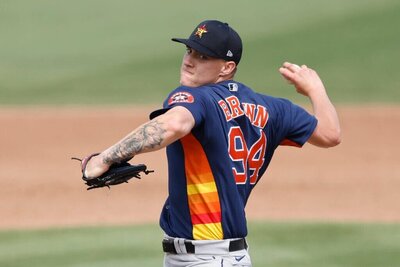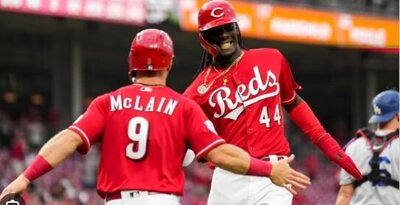Jeff Niemann SP (TB) – Niemann improved to 8-2 with a win over the Yankees yesterday, although he did not pitch particularly well yielding 4 ER over 6 IP thanks to 4 BB and 2 HR. Niemann is a guy who will likely struggle over the season’s second half, at least by comparison to his first half. Niemann now sits at 8-2 with a 2.92 ERA, but a lot of those numbers have been influenced by luck. His 84.5% LOB% is unsustainable and will likely drop down to his career mark of 76.7%, if not lower, over the season’s second half. Likewise, Niemann has a BABIP of .246. In 196.2 big league innings heading into this year, Niemann’s BABIP was easily over .300. If you can deal him now getting good value based on his record and ERA, do it before regression hits.
Carl Pavano SP (MIN) – Pavano tossed a complete game victory yesterday, allowing just 2 ER. That gives Pavano 11 wins and a 3.48 ERA. He should see a rise in ERA due to some luck in BABIP and LOB%, but I suspect even with some regression it remains sub-4 or right at 4 the rest of the season (FIP and xFIP are 3.93 and 3.90 respectively). I came into the season a big Pavano believer and am still one now. He had a K/BB ratio of 3.77 last season which was very solid, and this year his command has only gotten better with a 4.28 K/BB ratio. Perhaps just as important to Pavano’s success, though, is that his GB rate has improved by about 5 percentage points moving from an average 43.4% mark to an above average 48.6% mark. Pavano has a solid formula to success: don’t walk batters, strike out just enough batters and don’t yield too many long balls. That was all on display yesterday as over his 9 IP, Pavano gave up just 1 HR (a solo shot), walked no one and struck out 6.
Reid Brignac 2B (TB) – Brignac had a big day for the Rays yesterday, going 3-5 with 2 HR and 5 RBI. The young middle infielder has a disappointing AVG/OBP/SLG line of .273/.335/.402 on the season though. Brignac’s distribution of balls in play (22.1 LD%, 38.6 FB%) should allow him to hit for more power. However, his ISO sits at just .129. The problem? Brignac has a terrible EYE of .30. He walks just 7.1% while striking out 25.8% of the time. As one might suspect from those numbers, Brignac is chasing pitches outside of the zone an unacceptable amount of the time. His 40.6% chase percentage is about 12 percentage points higher than the rest of the league. Also indicative of Brignac’s lack of patience is the fact that he swings at 53% of all pitches he sees. The ML average is 45.4%. When you are swinging at pitchers’ pitches, it’s tough to hit for power as Brignac has found out and will continue to do so until he develops patience. This wasn’t a breakout performance for Brignac, just a good day over the course of the long season. If anything, I think his numbers get worse from here on out as his .273 batting average is heavily influenced by a .288 singles average (40 points above the ML average).
Josh Hamilton OF (TEX) – Hamilton is absurdly hot, he is still benefiting from a solid BABIP of .388 that likely won’t last. Still, that number isn’t totally outlandish when considering Hamilton has a career BABIP of .339. Also vital to Hamilton’s success has been a 20.8 HR/FB%, which is just slightly higher than his career mark of 18%. While looking at these numbers and examining Hamilton looking for something to say about him, I came across an often overlooked stat, which, although just a small piece of the puzzle, I think helps explain why Hamilton is successful. That stat is IFFB% or infield fly ball percentage, which quite simply is just the percentage of fly balls hit that are of the infield variety. In Hamilton’s case that number is extremely low and always has been. In fact his current 2.8 IFFB% is the worst of his career. With such a low number of infield fly balls, Hamilton does not hit into a lot of sure outs (positive impact on his BABIP) and sees the vast majority of his fly balls sent into the outfield (positive impact on his HR/FB%). Here are some other top players’ career IFFB%, just for comparisons sake: David Ortiz – 8.1%, David Wright – 6.8%, Albert Pujols – 13.4%. Hamilton’s career mark is 2.2%. Like I said, this is just one tiny puzzle piece as Pujols is the far and away the best hitter in baseball with a 13.4% mark. But it does matter. If Hamilton and Pujols both hit 200 fly balls, Hamilton has 23 more that are of the outfield variety. In other words, that’s 23 extra chances at a ball finding a gap for an XBH or one carrying over the outfield fence. In a season when a player is locked in and getting a little luck as well, those 23 extra chances can mean a whole lot.
Mark Buehrle SP (CHW) – Buehrle took the loss yesterday, but pitched well in a complete game effort. Since June 6th, Buehrle has seen his ERA drop from 5.40 to 4.18. Frankly, Buehrle has not pitched any better, but his bad luck has started to turn around. There’s still some room for him to improve, too. First of all, his BB/9 are his highest since 2003, so it’s likely he’ll walk less batters the rest of the season. The same can be said about Buehrle’s K rate, although there is the possibility that age related decline is setting in. On top of that, even after having a good stretch of starts, Buehrle’s BABIP is 21 points above his career average and LOB% is 2 percentage points below his career average (and worst since ’03). I’m usually not a huge Buehrle fan when it comes to fantasy due to his lack of dominance and perceived value, but I suggest fantasy owners continue to ride this hot streak.


































